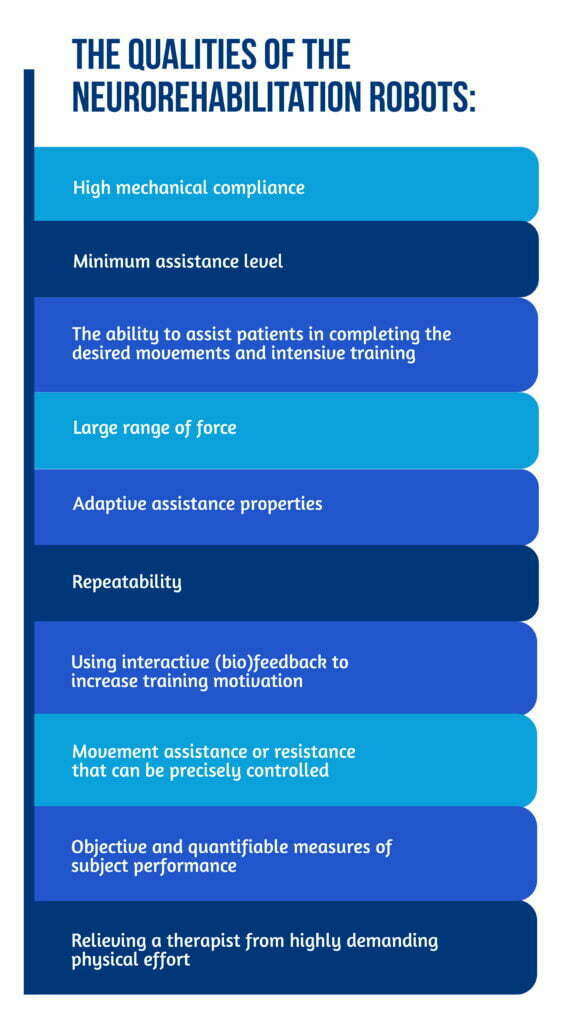Neurorobotics: What should neurorehabilitation robots do for health practitioners?

Authors: Irina Benedek, Oana Vanta
Keywords: Neuroscience, Rehabilitation, Medical Robots
Focus keywords: Neurorobotics
What is known about robots used in neurorehabilitation? A brief history and controversies.
The first medical robots destined for neurorehabilitation were created in the 1980s; their benefits were observed in the 1990s, while robotic exoskeletons began to spread in the 2000s. Nonetheless, the usefulness of robots in neurorehabilitation is still up for dispute [1].
Contradictory results were found in various studies about the effectiveness of these robots [2–3], even though some randomized controlled trials demonstrated that the outcomes of robotic-assisted therapy were significantly better than those obtained in traditional recovery. The objective effectiveness of robotic training has only partially been clarified by meta-analyses, with most of the findings being unclear [1].
Instead of debating whether robotic technology is effective in aiding neurological recovery, one should look into who can gain the most from these specialized initiatives [1].
When designing a study protocol, inclusion and exclusion criteria are not the only factors to consider. Only a few researchers have concentrated on developing rules for a more efficient selection of movement parameters (such as joint angles, speeds, applied forces, and torques) [1].
For more information about neurorehabilitation methods using robotic devices, visit:
- Efficacy of virtual reality augmented robot-assisted gait training in chronic stroke – results from a randomized controlled single-blind trial
- Robot-assisted neurocognitive rehabilitation of the hand
- Wearable elbow robot in rehabilitation after a stroke
- The Effectiveness of Robotic-Assisted Therapy in stroke rehabilitation
What is a neurorobot?
Identifying a device as a robot is independent of the sophistication of the machine. For example, a vehicle is typically more advanced than a cooking appliance, yet nobody considers automobiles to be robots. Contrarily, doctors and occasionally neuroscientists frequently confuse robots with electromechanical devices [4].
- According to the Robot Institute of America, a robot is: “a programmable, multi-functional manipulator designed to move material, parts or specialized devices through variable programmed motions for the performance of a variety of tasks” [5].
- The field of research integrating neurology, robotics, and artificial intelligence is known as neurorobotics (Figure 1). This concept refers to all robots created to interact with or simulate human neurological systems [1].

A robot should be able to carry out a range of tasks, as was already indicated. This flexibility is based on the robot’s internal sensors, whose signals are processed by artificial intelligence. Therefore, the critical distinction between robots and electromechanical devices is their operation’s adaptability. Neurorehabilitation frequently criticized this distinction as being picky, and assessments of the usefulness of robots and electromechanical devices often group these two [6].
What qualities should a neurorehabilitation robot possess?
Numerous neurorehabilitation strategies and methods have been developed to improve neuromotor function. The goal was to help patients with neurological diseases regain their normal movement patterns. None, however, reached the gold standard, since it is widely believed that approaches should be uniquely adapted for patients and illnesses. Despite this, all these neurorehabilitative methods require intense, repeated, and task-oriented therapies [1]. The qualities of neurorehabilitation robots [1] are presented in Figure 2 below:

What is the Effectiveness Paradox in Neurorobotics?
The Effectiveness Paradox in Neurorobotics refers to the contrasting needs of:
🡪 Highly individualized treatment options for patients (FLEXIBILITY)
This refers to programming the robot to use each patient’s remaining capacities to regain a functional status. To achieve this, clinical studies should be directed at extremely particular populations [1].
🡪 The need for sufficient statistical evidence to support a standard therapy (UNIFORMITY)
Targeting a highly particular population leads to a smaller sample size, therefore, a lack of sufficient statistical evidence [1].
There are other issues in designing a methodologically rigorous study, such as the:
- Increased risk of causing or exacerbating spasticity from intense training
- Monotony of repeating workouts with the same trajectory. This contradicts the requirement for robots to continually adjust to patients’ evolving skills.
- Need for inspiring exercises rather than tedious ones [1].
Finally, most robots help patients replicate a movement that resembles a physiological one, even though most severely damaged patients have a low probability of entirely recovering [1].
It should be highlighted that similar contradictions exist in traditional neurorehabilitation training as well. Neuromotor physiology, neurorehabilitation, and brain plasticity have unclear scientific foundations. The appropriate course of treatment for neurorehabilitation is still mostly ill-defined, with opposing schools of thought. Interestingly, the fact that relatively identical assessments may be developed for the range of human-delivered rehabilitation procedures does not lessen the scepticism surrounding neurorobotics due to the somewhat inconclusive evaluation of its efficacy and the observed discrepancies [4]. As a result, there may be other obstacles preventing neurorobotics from being used more widely in rehabilitative settings and concerns regarding their effectiveness [1].
What other barriers exist that might limit the development of neurorobotics?
The main limitations are presented in Figure 3 below:

Robot adoption in neurorehabilitation may be constrained by the initial financial impact, despite reports suggesting that long-term usage of neurorobotics can reduce healthcare system expenditures. For instance, a single physical therapist may simultaneously handle up to four robots (and hence, four patients) [7].
The likelihood that patient and clinician expectations for outcomes of a neurorobotic treatment are excessive, given the state of biomedical engineering today, might be connected to technological and behavioral factors. These explanations sound plausible, but they also raise the question of why similar expectations have not been placed on other medical robot types, such as surgical robots [1].
Bibliography
- Iosa M, Morone G, Cherubini A, Paolucci S. The Three Laws of Neurorobotics: A Review on What Neurorehabilitation Robots Should Do for Patients and Clinicians. J Med Biol Eng. 2016;36:1-11. doi: 10.1007/s40846-016-0115-2.
- Hidler J, Nichols D, Pelliccio M, Brady K, et al. Multicenter randomized clinical trial evaluating the effectiveness of the Lokomat in subacute stroke. Neurorehabilitation and Neural Repair. 2009;23:5–13. doi: 10.1177/1545968308326632.
- Husemann B, Müller F, Krewer C, Heller S, Koenig E. Effects of locomotion training with assistance of a robot-driven gait orthosis in hemiparetic patients after stroke: A randomized controlled pilot study. Stroke. 2007;38:349–354. doi: 10.1161/01.STR.0000254607.48765.cb.
- Morasso P, Casadio M, Giannoni P, Masia et al. Desirable features of a “humanoid” robot-therapist. Conference proceedings: Annual International Conference of the IEEE Engineering in Medicine and Biology Society, 2009:2418–2421. Available at: https://pubmed.ncbi.nlm.nih.gov/19965200/
- Xie Ming. Fundamental of robotics: Linking perception to action. Singapore: World Scientific; 2003. Available at: https://doc.lagout.org/science/0_Computer%20Science/8_Electronics%20&%20Robotics/Fundamentals%20of%20Robotics%20Linking%20Perception%20to%20Action%20-%20Ming%20Xie.pdf
- Iosa M, Morone G, Fusco A, Bragoni M et al. Seven capital devices for the future of stroke rehabilitation. Stroke Research & Treatment. 2012;2012:187965. DOI: 10.1155/2012/187965
- Masiero S, Poli P, Rosati G, Zanotto D et al. The value of robotic systems in stroke rehabilitation. Expert Review of Medical Devices. 2014;11(2):187–198. doi: 10.1586/17434440.2014.882766.









